The Haflinger is a horse breed that is loved for its gorgeous look and gentle temperament. Due to their distinct golden chestnut coat and flaxen mane and tail, Haflingers are widely recognized among other breeds. The best description of the Haflinger horse breed is little but mighty. We compiled a list of fascinating facts about this equine. Let’s get the hang of such a horse breed.
What Is a Haflinger Horse?
The Haflinger Horse is also called the Avelignese. However, some people presume the Avelignese is another horse breed. There’s no reference in the American Haflinger Registry regarding the Avelignese breed.
This horse breed originated from Austria and Italy. It was developed from abandoned horses in the Tyrolean valleys in the 19th century. The main purpose of breeding was to create a hardy equine to withstand mountainous terrains. In later years, after the wars, the Haflinger Horse was crossbred with other horses to save the breed. According to the World Haflinger Breeding, the first international organization was established in Tyrol in 1976. Currently, the horse’s conformation has changed since various bloodlines were infused.
Haflinger horses are small and sturdy equines that are used in a range of activities. You may face the breed in different horse disciplines to be ridden under the saddle. These include dressage, vaulting, endurance riding, and therapeutic riding. Besides, the Haflinger breed is used as a draft horse for harness working, pulling, and farming.
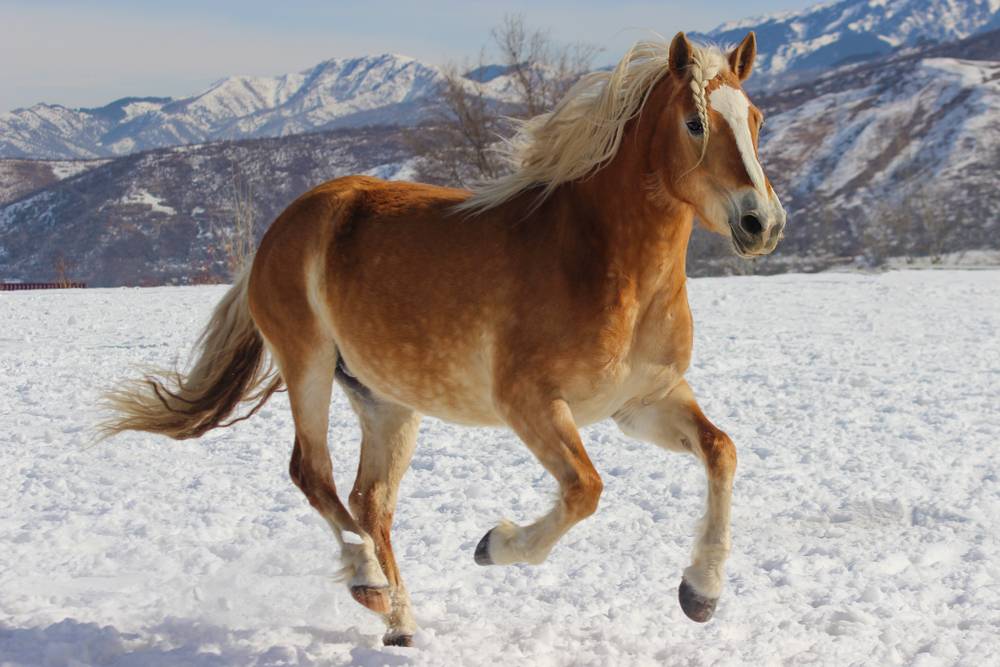
The History of Haflinger Horses
The birth of the extraordinary Haflinger horse breed can be traced far back to the 19th century in South Tyrol’s village of Hafling. The foundation stallion was called Folie – a one-of-a-kind half-Arabian stallion born in 1874. The golden stallion named Folie was responsible for first creating this breed when he mated with a native Tyrolean mare. His descendants eventually became known as the strong and surefooted purebred Haflingers.
Initially, Haflingers were used as workhorses in the mountainous regions of Austria and Northern Italy. These mountain horses were bred to be strong and agile, capable of carrying heavy loads up steep terrain. The equines have experienced impressive changes in conformation. It went from the light mountain pony and ended up being one of the hardiest horse breeds.
In the early 20th century, the Haflinger breed was officially recognized. It resulted in emerging of breeding programs to maintain and improve the breed’s characteristics.
In 1922, Austria’s Tyrolean Haflinger Breeding Association was established. Its goal lies in advancing and enhancing the quality of the breeding stock. By the mid-century, it had become a beloved animal across Europe and beyond.
Established in 1977, the US-based Haflinger Horse Association was created to advance and maintain the breed in North America. They offer support for both Haflinger breeders and owners. The organization hosts events so that people can see firsthand how versatile these healthy horses are. The World Haflinger Federation is now active worldwide with associations present across twenty countries.
The Haflinger breed’s impressive adaptability and versatility make the equine quite popular among other horse breeds. From dressage riding to driving, jumping, and trail riding – these horses can do it all. Their kind temperaments also make them ideal for therapeutic riding programs.
Despite its popularity, the breed was threatened with potential extinction in the mid-20th century due to diminishing demand for workhorses. Preserving and protecting this remarkable species became of utmost importance. To ensure they wouldn’t face total eradication, Austria implemented a closed studbook after World War II. It’s strictly devoted to tracking their lineage as well as implementing breeding standards tailored just for them.
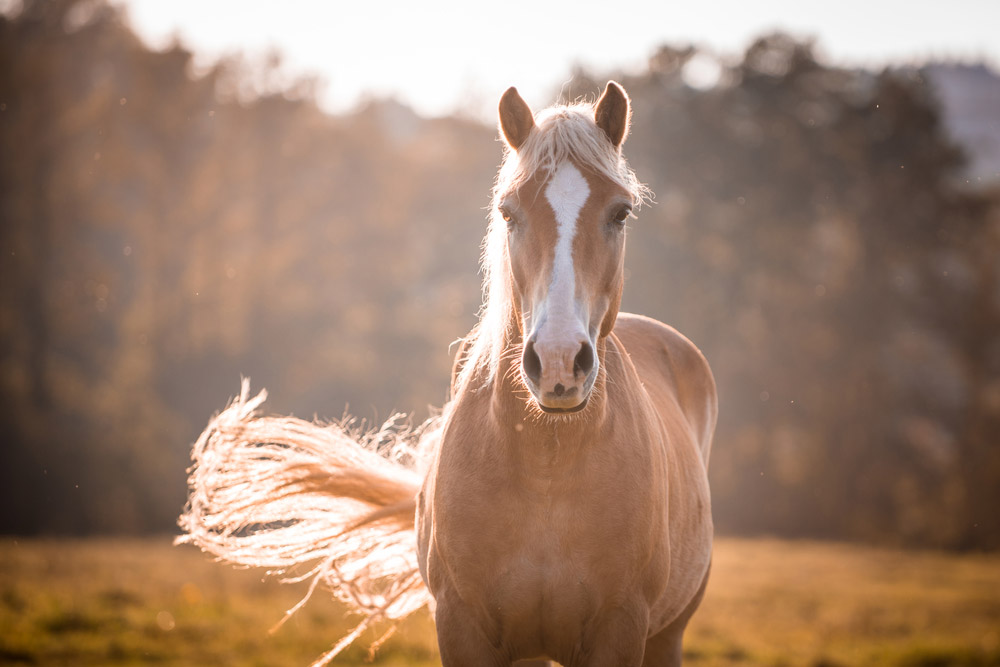
Haflinger Horse Temperament
The Haflinger has a gentle and friendly temperament. They are considered excellent companions for farmers and children. Therapeutic riding sessions involve Haflinger horses as they get on with people well.
The Haflinger horses are laid-back equines that are great family horses. They are calm enough to work with beginner riders and kids. These features are beneficial for riders who want to improve their confidence. The horse is willing to please its horseman so you can have fun together.
Another perk is that the breed is highly versatile due to its small and stocky stature. You can flawlessly use the Haflinger horse in a wide range of equestrian disciplines. Moreover, it will definitely stand you in good stead as a working horse. They have compact bodies, but Haflinger horses are hardy to withstand heavy workloads.

The First Cloned Horse
On May 28, 2003, in Cremona, Italy, the world was introduced to Prometea – the first cloned horse ever. This remarkable feat was accomplished through a partnership between two labs. They were the Laboratory of Reproductive Technology at the University of Teramo and The Laboratory of Comparative Genetics based within the Italian National Research Council. The experiment aimed to get great advancements in equine genetics and reproductive technology.
Cloning Prometea was an intricate, drawn-out process that incorporated somatic cell nuclear transfer (SCNT). This strategy requires the nucleus of a non-reproductive somatic cell to be placed into a stripped egg cell. It can then be stimulated to divide and form an embryo. Afterward, this embryo is transferred into a surrogate Haflinger mare in order for it to develop as a foal.
Despite the difficulties, Prometea was cloned successfully with a healthy birth and minimal issues. This success story is highly significant for both scientists and the equine industry alike. It has opened up tremendous possibilities when it comes to breeding and genetic enhancements.
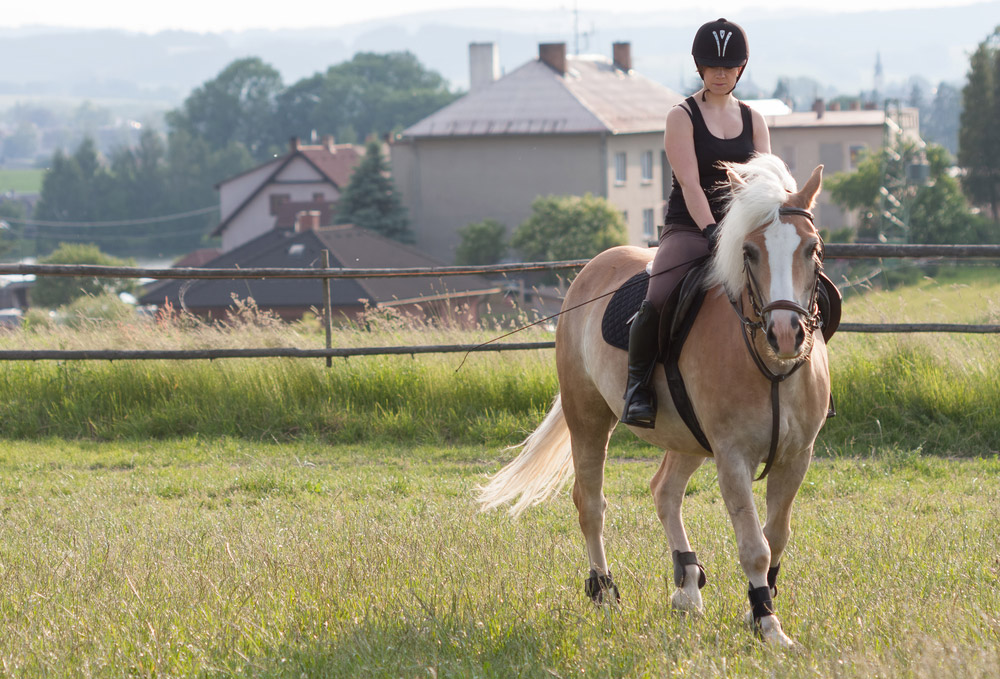
10 Haflinger Horse Facts You Should Know
1. Crossbreeding
The Haflinger has the bloodline of the Arabian Horse. It’s believed the first Haflinger was the result of crossbreeding between the Arabian and a pony of Austria and Italy origin. You may notice some Haflinger horses have a distinguishing Arabian head shape.
2. The Foundation Horse
The progenitor of the Haflinger breed was a sire named 249 Folie. It was born in 1874. All the representatives of the breed can trace the pedigree back to Folie. There are seven stallion lines through which you can track the lineage:
- A-line – Anselmo, born in 1926.
- B-line – Bolzano, born in 1915.
- M-line – Massimo, born in 1927.
- N-line – Nibbio, born in 1920.
- S-line – Stelvio, born in 1923.
- ST-line – Student, born in 1927.
- W-line – Willi, born in 1921.
Colts usually get a name beginning with the letter of the stallion line. While fillies get a name beginning with the letter of the name of their dam.
3. Friendly Temperament
As we already mentioned, Haflinger horses are outgoing equines. They are great for keeping them at the farm. Such horses are willing to please and entertain. They will be a superb companion for little kids too. Consider a Haflinger horse for a beginner rider. The breed can be suitable for a wide array of riding disciplines.
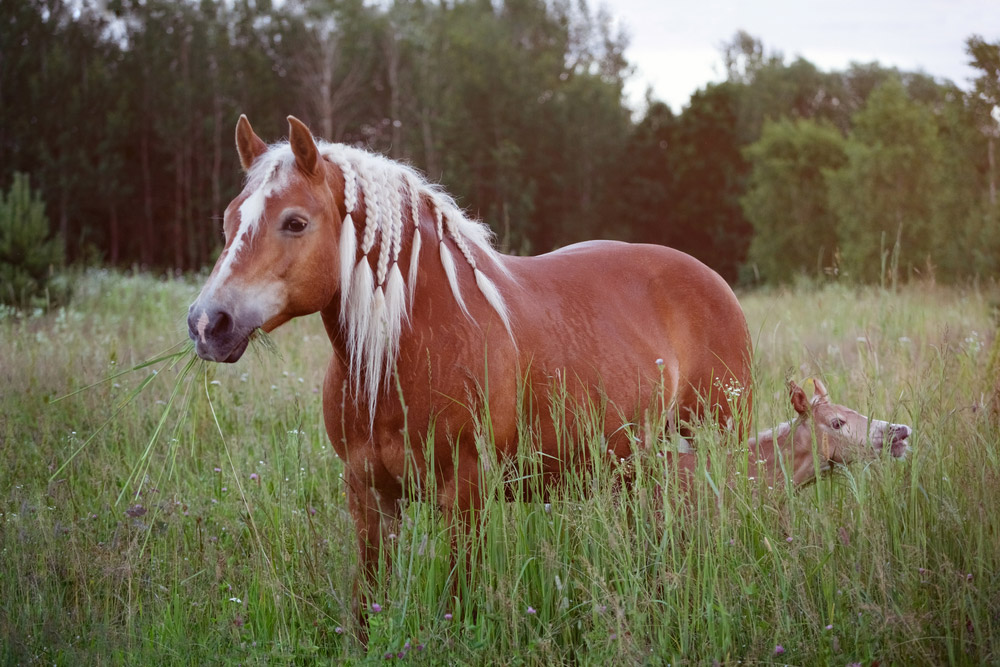
4. Easy-Keepers
The Haflinger horse is not a fussy eater. Thus, the horse care routine is easy and delightful. The breed can live on limited pasture, grain, and hay supply. For Haflinger horses that work hard, it’s better to provide a diet with low-starch and low-sugar feed. Make sure you provide enough water to avoid dehydration.
5. Color Options
Mind that Haflinger horses come in a chestnut color only. However, you may expect different shades of color. These include light gold and pale chestnut. For instance, dark liver chestnut is called chocolate color. The breed usually has a rich golden chestnut coat and cream or white mane and tail. There are also white markings on the equine’s head and lower legs (white socks).
6. Horse or Pony?
The Haflinger breed has a compact body. Some people tend to think it’s a pony breed. It makes sense as pony ancestors are recorded in the pedigree. But the truth is the Haflinger is a horse breed.
The average height of the Haflinger horse is 13.2 to 15 hands. Most equines that are lower than 14.2 hands are referred to as ponies. But there are several exceptions, and the Haflinger is considered a horse. Besides, the breed is more horse-like according to its behavior and temperament. The animals with a steady nature are willing to work and train.

7. Conformation
The breed stands out with its compact and elegant body. The average weight is between 800 and 1,300 pounds. The head is lean and expressive. The eyes are large, and the neck is well-formed. The horse has pronounced withers, sloping shoulders with a deep chest. The croup is well-divided, and the limbs are defined. The knees are flat and broad. The back is muscular and medium-long.
8. Gaits
The Haflinger horse features ground-covering and rhythmic gaits. The walk is energetic and at the same time relaxed. The trot and canter are athletic and well-balanced. They tend to be energetic and elastic. The canter sticks out with its distinguishing knee action. It has a clear motion forward and upward.
9. Life Expectancy
Haflinger horses have long life spans. The average life expectancy is 25 to 30 years, which is impressive. Moreover, mares are able to produce foals in their twenties with no issues. And go on living into their thirties.
10. Price
The Haflinger is an affordable horse breed. You can buy a Haflinger horse for $5,000 to $10,000. Competitive show horses will cost you more – $20,000 and higher. The price range depends on an array of factors. These are age, gender, health condition, and more.

Common Health Issues in the Haflinger Horse Breed
In Haflinger horses, lameness is an abnormal gait that can stem from joint pain, muscle strain, and hoof complications. This condition should be taken seriously as it may lead to reduced performance for the equine in question.
Haflinger horses have a heightened susceptibility to colic due to their hearty eating habits and proclivity for overindulging. Colic is an ailment that can be caused by various factors such as diet, stress, or intestinal obstructions. It is consequently resulting in abdominal pain.
The Haflinger breed has a heightened susceptibility to respiratory illnesses like allergies, pneumonia, and equine asthma. These issues can be triggered by environmental conditions like dust or mold but also by infectious agents.
Haflingers can be easily exposed to eye complications, such as corneal ulcers and conjunctivitis. These issues are typically due to external irritants or physical trauma toward the eyes. Horse owners should take precautionary measures in order to protect their companion’s vision from harm.
When it comes to skin conditions, Haflinger horses unfortunately are quite vulnerable. These issues, such as rain rot and sweet itch, can be attributed to parasites, allergies, or environmental irritants.
Unfortunately, dental conditions are a prevalent issue for Haflingers. These concerns can range from misalignment to tooth decay and more. A proper diet should be tailored to the horse that will help avoid dental issues. Some owners consider a grazing muzzle to prevent metabolic issues.
Haflinger horses should be carefully monitored for metabolic disorders, such as equine metabolic syndrome and insulin resistance. If left untreated, these issues can cause weight gain in your horse and other serious health problems. Laminitis is another painful hoof condition that Haflingers often experience. Owners should check their horse’s hooves regularly to prevent severe issues.
Equine Degenerative Myeloencephalopathy (EDM) is a neurodegenerative disease that can affect Haflinger horses. EDM is caused by a mutation in a gene that affects the metabolism of vitamin E. The mutation causes a deficiency in vitamin E, which may lead to neurological symptoms or even death.
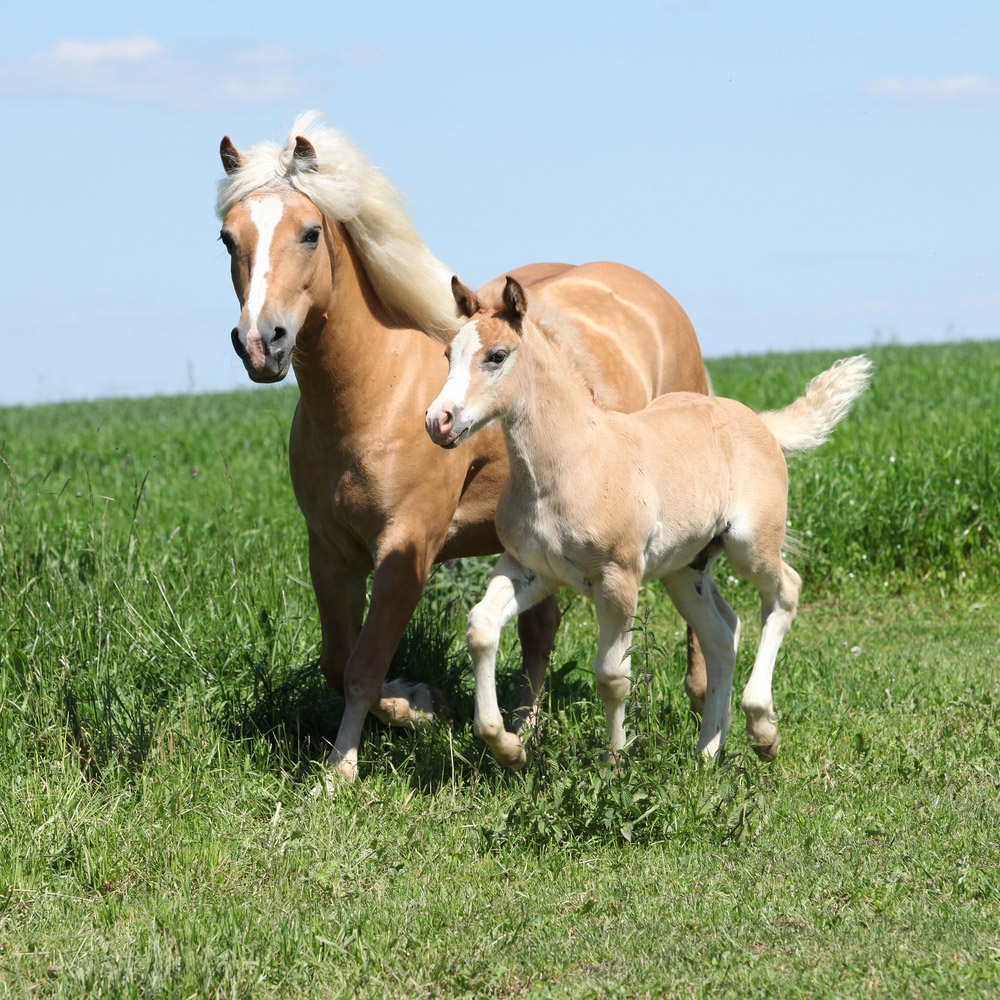
The Haflinger Horse as the Best Companion
The Haflinger is an excellent choice for beginner riders. They are extremely friendly and communicative. The animals are easy to train as they are willing to work. That’s a great option for kids too. Lots of Haflinger horses are used in hippotherapy to help people overcome their physical and mental issues.
Haflinger horses are famous for their elegant look. They have compact bodies, but the breed is hardy. You can use the horse for farming as well as partaking in equestrian sports. The horse care is a pleasure as they require little feed.
